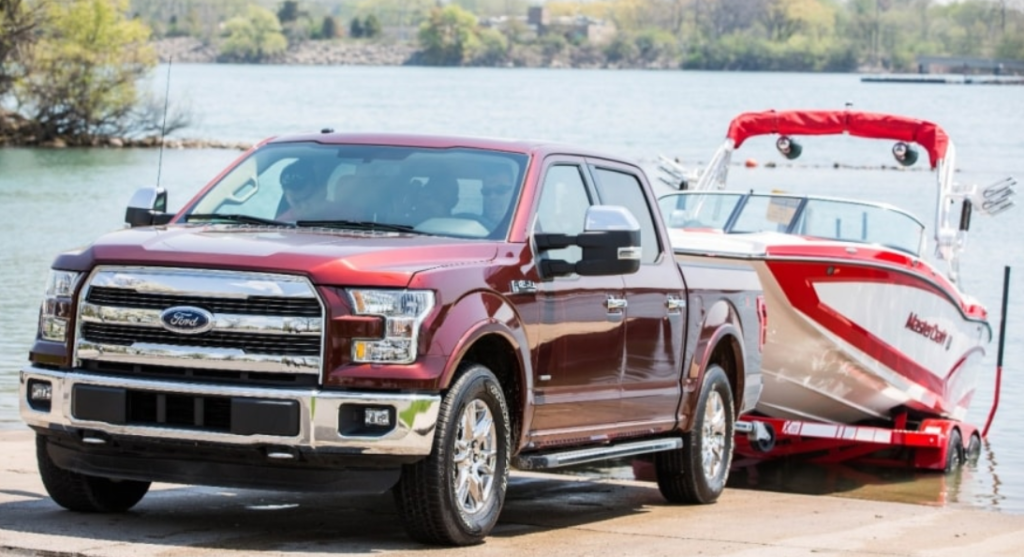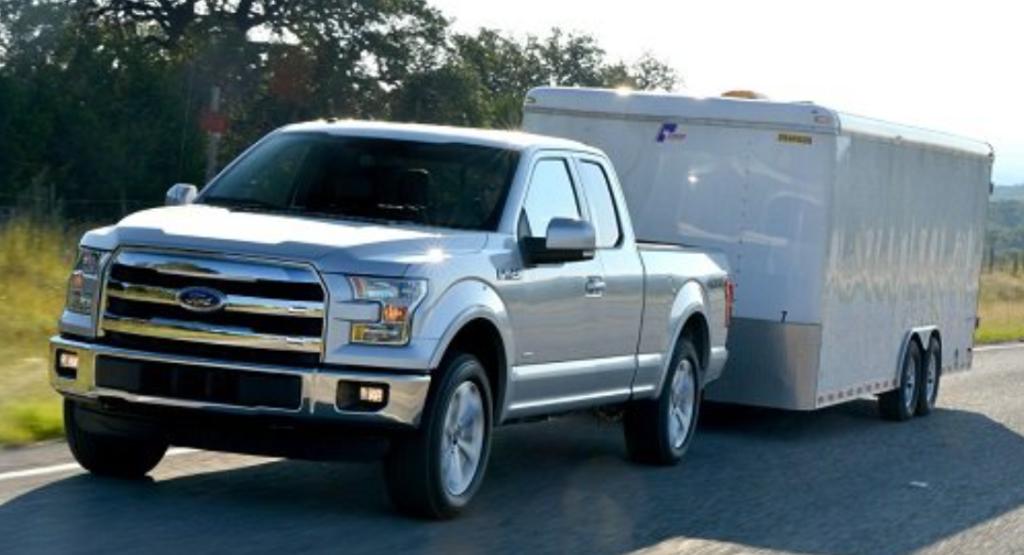Towing capacity has been a focal point for pickup truck enthusiasts and professionals for years. As the needs of consumers have grown, so has the importance of understanding just how much a truck can handle in terms of towing.

The Role of Towing Capacity in Pickup Trucks
When it comes to pickup trucks, towing capacity isn’t just a number—it’s a measure of the truck’s capability, strength, and utility. Whether it’s for recreational purposes like hauling a boat or camper, or more professional needs such as transporting heavy equipment, a truck’s towing capacity can dictate its utility in various scenarios. For many, this figure, including the 2016 F150 towing capacity, is a primary factor in their purchasing decision.
Why Configuration Matters: Setting the Stage for the 2016 F150
Every truck model comes with different configurations: from engine types to bed lengths and even the type of wheels. Each configuration plays a pivotal role in determining the overall towing capacity. With the 2016 F150, understanding these configurations is crucial, as it directly influences the 2016 F150 towing capacity, ensuring users harness the full potential of the truck.
The Essence of the 2016 F150
The Ford F150, an icon in the pickup truck market, has seen continuous evolution in its design, technology, and performance.
Overview: Ford F150’s Legacy
The Ford F150 has a storied legacy as America’s best-selling pickup truck for several decades. Each model year brings with it improvements, refinements, and often, increased capabilities. The 2016 F150 towing capacity stands as a testament to Ford’s commitment to blending power with modern-day demands.
Key Features of the 2016 Model Year
The 2016 F150 introduced a range of advancements. Lightweight aluminum body construction reduced the truck’s weight, improving fuel efficiency without compromising on strength. Enhanced safety features, state-of-the-art infotainment systems, and improved drivetrain options also set the 2016 F150 apart. Each of these enhancements, directly or indirectly, plays into the 2016 F150 towing capacity, ensuring that it remains competitive in its segment.
Importance of Engine Types
One can’t discuss towing capacity without focusing on the engine—the heart of every vehicle. The type, size, and technology integrated into an engine can greatly influence a truck’s capability.
The Heart of the Truck: How Engines Influence Towing
The engine is the primary source of a truck’s power. Its size, measured often in terms of liters and configuration (like V6 or V8), can dictate not only horsepower but also torque—a critical factor for towing. The greater the torque, the more weight a truck can pull from a standstill. This principle directly feeds into the 2016 F150 towing capacity, which varies based on the engine option chosen by the buyer.
Advancements in Ford’s Engine Technologies in 2016
Ford introduced several engine options for the 2016 F150, each catering to different needs. From the fuel-efficient 2.7L EcoBoost V6 to the powerful 5.0L V8, choices abound for consumers. These engines came with advanced turbocharging and direct fuel injection technologies, optimizing performance and efficiency. The synergy of these technologies not only boosts the overall performance but significantly impacts the 2016 F150 towing capacity, providing options suitable for a range of towing needs.
The 2016 F150 stands as an exemplar of Ford’s commitment to melding power, technology, and practicality. As consumers, understanding the intricacies of configurations, especially the engine types and related advancements, can help unlock the full potential of the 2016 F150 towing capacity, ensuring safe and efficient towing for any purpose.

Towing Capacities Based on Engine Types
The 2016 F150, with its diverse engine options, provides users with a range of towing capacities to suit individual needs. Each engine type has its unique set of characteristics, determining the 2016 F150 towing capacity.
2.7L EcoBoost V6: Features and Towing Specs
The 2.7L EcoBoost V6, with its turbocharged design, offers a balance between fuel efficiency and power. This engine is designed for the modern-day user who requires both daily drivability and occasional heavy lifting. With 325 horsepower and 375 lb-ft of torque, the 2016 F150 towing capacity with this engine can reach up to 8,500 pounds, making it suitable for towing small trailers, boats, or campers.
3.5L V6 Ti-VCT: Breakdown and Capacities
The 3.5L V6 Ti-VCT is the standard V6 option, blending performance with reliability. Producing 282 horsepower and 253 lb-ft of torque, this engine showcases versatility. For the 2016 F150, towing capacity with the 3.5L V6 Ti-VCT stands at approximately 7,600 pounds, making it apt for medium-sized towing tasks.
3.5L EcoBoost V6: Powerhouse Explained
Regarded as a powerhouse, the 3.5L EcoBoost V6 is for those who prioritize performance. With 365 horsepower and a massive 420 lb-ft of torque, this engine is designed for heavy-duty applications. The 2016 F150 towing capacity reaches its peak with this engine, boasting capabilities of up to 12,200 pounds, catering to larger trailers and heavier payloads.
5.0L V8 Ti-VCT: The Mighty V8 and its Capabilities
For those who swear by V8 engines, the 5.0L V8 Ti-VCT offers a harmonious blend of power and tradition. Delivering 385 horsepower and 387 lb-ft of torque, this engine’s robustness is undeniable. The 2016 F150 towing capacity with the 5.0L V8 is approximately 11,100 pounds, ensuring it can handle substantial towing challenges with ease.
The Role of Drivetrains in Towing
Drivetrain configurations can significantly influence towing performance and capacity.
2WD vs 4WD: What’s the Difference?
2WD (Two-Wheel Drive) means that only two of the vehicle’s wheels receive power from the engine, typically the rear wheels in trucks like the F150. In contrast, 4WD (Four-Wheel Drive) ensures all four wheels get powered, providing better traction and stability, especially on uneven terrains or challenging conditions.
How Drivetrain Choices Affect Towing Capacity
While the engine primarily dictates the 2016 F150 towing capacity, drivetrain plays a pivotal role in real-world applications. A 4WD can tow more effectively on rough terrains or slippery conditions due to better traction. However, 4WD trucks usually weigh more than their 2WD counterparts, which might slightly reduce their maximum towing capacity.
Delving into Axle Ratios
Axle ratio is a crucial factor influencing towing capacity and overall truck performance.
What is an Axle Ratio and Why Does it Matter?
The axle ratio, often referred to as the differential ratio, represents the number of times the driveshaft rotates compared to the wheels. For example, an axle ratio of 3.55:1 means the driveshaft turns 3.55 times for every single turn of the wheels. A higher axle ratio offers more towing power but might reduce fuel efficiency.
Common Axle Ratios for the 2016 F150 and Their Impacts
The 2016 F150 offers various axle ratios, including 3.15:1, 3.31:1, 3.55:1, and 3.73:1. A 3.15:1 ratio leans towards better fuel efficiency, while 3.73:1 is designed for heavier towing tasks. The right balance depends on individual needs, but it’s crucial to note that the axle ratio can significantly influence the 2016 F150 towing capacity.
The 2016 F150’s towing capacity is a complex interplay of engine types, drivetrain configurations, and axle ratios. By understanding these components, owners can optimize their F150’s performance, ensuring safety, efficiency, and the longevity of the truck.
Towing Equipment: Enhancing the Truck’s Abilities
The 2016 F150, renowned for its robustness and versatility, is an ideal companion for towing, but having the right equipment is crucial. While the 2016 F150 towing capacity sets a standard, the equipment you use can make a significant difference in both safety and efficiency.
Factory-Installed vs Aftermarket: What to Know
When purchasing the 2016 F150, many opt for factory-installed towing equipment, ensuring compatibility and reliability. Factory equipment is meticulously tested with the vehicle, providing an assurance of performance.
However, the aftermarket also offers a plethora of options that can potentially boost the 2016 F150 towing capacity or cater to specific needs. While aftermarket components can provide customization, it’s essential to ensure they meet the vehicle’s specifications and are installed correctly to avoid any safety issues.
Essential Towing Equipment for the 2016 F150
Several pieces of equipment are crucial for maximizing the 2016 F150 towing capacity safely:
- Tow Hitch: This is the primary connection between the truck and the trailer. Different types like the fifth-wheel hitch or receiver hitch cater to different towing needs.
- Wiring Harness: This ensures that the trailer’s electrical systems, like brake lights, are synchronized with the truck.
- Brake Controller: Especially essential for heavier loads, it allows the driver to control the trailer’s brakes, ensuring synchronized stopping.
- Tow Mirrors: Larger and more extended than standard mirrors, these provide a clearer view of the trailer and its surroundings.
- Sway Control: This helps prevent the trailer from swaying side-to-side during towing, particularly in windy conditions or at higher speeds.
8. Other Configurations Affecting Towing Capacity
While engine type, drivetrain, and axle ratios are pivotal in determining the 2016 F150 towing capacity, other configurations play a role.
Impact of Cab Size on Towing
The 2016 F150 offers various cab sizes, including Regular, SuperCab, and SuperCrew. The choice of cab size can influence the overall weight of the truck. A larger cab, while providing more interior space, might slightly reduce the 2016 F150 towing capacity due to the added weight.
Bed Length: Short, Standard, or Long?
Bed length is another factor. The 2016 F150 provides options like the 5.5-ft short bed, 6.5-ft standard bed, and the 8-ft long bed. A longer bed can accommodate more cargo but remember that increased cargo weight will directly impact how much you can tow without exceeding the truck’s Gross Combined Weight Rating (GCWR).
Practical Tips for Safe Towing
Being informed about the 2016 F150 towing capacity is one thing, but employing best practices ensures safety on the road.
Matching Your Load to Your Truck’s Capacity
Always ensure that the weight of the trailer, combined with its load and the truck’s cargo and passengers, doesn’t exceed the 2016 F150 towing capacity. Regularly checking and adjusting based on weight ensures safe and efficient towing.
Safety Precautions for Towing with the F150
- Regular Inspection: Before setting off, always inspect the towing equipment, ensuring there are no signs of wear or damage.
- Balanced Loading: Distribute weight evenly across the trailer to prevent swaying or imbalances.
- Slow Down: When towing, reduce your speed, allowing more time for braking and maneuvering.
- Use Engine Braking: Downshifting can help slow down without excessively wearing out the brakes, especially when descending.
- Maintain a Safe Following Distance: With added weight, the stopping distance increases. Ensure there’s ample space between you and the vehicle ahead.
The 2016 F150 is a marvel in the world of trucks. Its impressive towing capacity, combined with the right equipment and practices, ensures that every towing task is safe, efficient, and reliable. By understanding and respecting the truck’s specifications and capacities, you are sure to have countless successful journeys on the road.

Cross-Reference: Using the VIN for Accurate Towing Info
Your 2016 F150 is more than just a powerful engine and a sturdy frame; it has an identity, a unique one that can be found in its Vehicle Identification Number (VIN). This number not only holds the essence of the truck’s origin but also vital information related to its capabilities.
Importance of the Vehicle Identification Number
The VIN is like the DNA of your truck. Comprising a series of numbers and letters, it encodes various aspects of the vehicle, from its manufacturing origin to its engine type. By deciphering this code, one can obtain crucial data about the truck’s specifications, ensuring the safety and efficiency of towing operations. Recognizing the 2016 F150 towing capacity using the VIN ensures accurate and personalized information.
Steps to Retrieve Towing Capacity from VIN
- Locate Your VIN: Commonly found on the driver’s side dashboard, visible through the windshield, or inside the driver-side door on a sticker.
- Enter the VIN: Use online VIN decoders or official Ford databases to input the number.
- Review the Specifications: The decoded information will provide a comprehensive breakdown, including the 2016 F150 towing capacity specific to that VIN.
- Cross-Check with Manual: Always validate the decoded information with the truck’s user manual or official Ford sources for the utmost accuracy.
Conclusion
The 2016 Ford F150 is not just another truck on the road; it’s a testament to Ford’s dedication to performance, safety, and versatility. Its adaptability to different towing needs, backed by a range of configurations and the legacy of the F-series, makes it a worthy companion for both daily drives and challenging hauls.
While power is an integral aspect of the 2016 F150 towing capacity, it goes hand-in-hand with safety. Understanding the configurations, from engine types to bed lengths, axle ratios to towing equipment, ensures that the power is harnessed safely and efficiently.
FAQs
Can I increase my F150’s towing capacity with aftermarket products?
While certain aftermarket products can enhance towing performance, they might not officially increase the towing capacity. Always consult with professionals and ensure any modifications are safe and compliant with regulations.
Does frequently towing at max capacity affect the truck’s lifespan?
Towing at or near max capacity regularly can place additional stress on the vehicle components, potentially affecting its lifespan. Regular maintenance and check-ups can mitigate the risks.
What other resources can help me understand my F150’s towing limits?
The owner’s manual is the primary resource. However, official Ford dealerships, trusted mechanics, and online communities of F150 enthusiasts can provide valuable insights.
Are there legal restrictions on towing over the specified limits?
Yes, towing over the specified limits can lead to legal repercussions, including fines and invalidated insurance. It’s crucial to stay within the legal and safe limits set by the manufacturer and local regulations.
How do I ensure my towing equipment is installed correctly?
Always rely on professionals for installation. Regular inspections and adhering to the equipment’s guidelines and weight limits ensure optimal performance and safety.
In essence, understanding and respecting the 2016 F150 towing capacity ensures not only the optimal performance of the vehicle but also the safety of the driver, passengers, and others on the road. Armed with knowledge and following best practices, the F150 becomes an unmatched asset on any journey, be it for work or leisure.